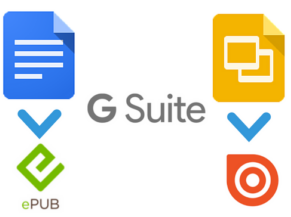G Suite Approach 1: Google Document to ePub
An underutilized feature of G Suite is the ability to export a Google Document as an ePub file. ePub is a universal file type that can be read as a digital book on most mobile devices, MacBooks with the iBooks App, and even Chromebooks with ePub reader-apps installed. By combining the power of G Suite and Google Docs collaboration with the ePub exporting feature, students can now collaborate to write and publish outside of the G Suite environment to a larger audience of their choice. The process (shown below) consists of creating content within a Google Doc and then exporting it: File --> Download As --> ePub Publication (.epub)
Once downloaded, the ePub file can be published and shared online for anyone to download and read.
There are several approaches to publishing and sharing a digital book in a way that anyone can download and read the text. Students could upload their digital book back to Google Drive and make the .ePub file accessible to anyone via a link. ePub files can also be uploaded to the Apple iBookstore by creating an iTunes Connect account and uploading files with iTunes Producer.
G Suite Approach 2: Google Slides to Issuu
Another approach to publishing eBooks via G Suite is to transform Google Slides into a book creation platform. Whereas slides are typically viewed as a tool to create presentations, they can also become a collaborative book-creation platform where each slide represents one page of the eBook. Because slides easily accommodate images via either the “Explore” tool or from images inserted from mobile devices, eBook creation with slides allows students to easily integrate images into their creation. Once students are done creating their collaborative eBook -- with a combination of digital text, web-based images via the “Explore” tool or even with photographs of offline creations via mobile devices -- they can proceed to export the slides as follows:File --> Download As --> PDF Document.
Once downloaded, the PDF document is uploaded to Issuu. Issuu is a free, web-based publishing tool that transforms PDFs into online eBooks that creates a page-turning reading experience online. As a publishing platform, Issuu is exceptionally flexible as eBooks can be read from any device with access to the link.
Moving Forward:
Both approaches to creating and publishing eBooks via G Suite apply to specific-use cases and classroom scenarios. While each approach can be created and edited on any device (Chromebook, iPad, laptop), the “Approach 1” would be used primarily if the intention is for the end user to read the eBook on a mobile device. “Approach 2” is best used if the eBook is intended for a broader audience that might access the eBook on a number of devices, including laptops.
Publishing student creations outside of a school G Suite domain can have a tremendous impact on the purpose and meaning of student work. Both of these approaches have the potential to create an authentic audience for student work, an audience that can amplify student voice and motivate students to become creators and publishers.


